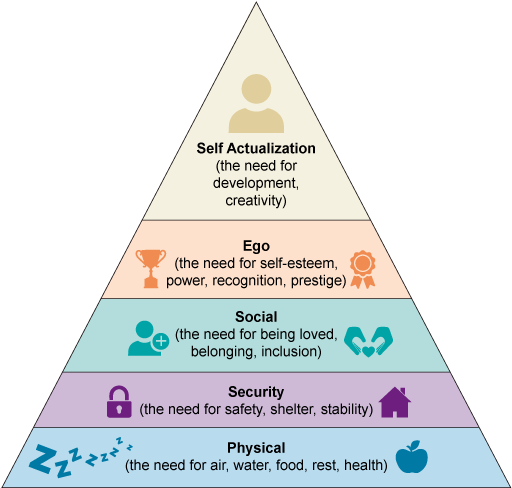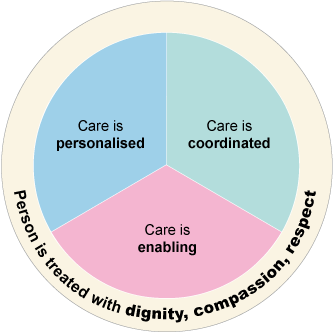The main objective of the work of health and social care services is to provide care of the highest quality. It is impossible to do so without paying attention to universal human needs that need to be met for a person to be minimally satisfied. Moreover, when focusing on high-quality care, one is to speak about person-centered care, which puts a patient’s needs and desires at the forefront. The aim of this essay is to discuss Maslow’s hierarchy of needs and person-centered care and how they are crucial in the provision of care to adults. Both these concepts are necessary foundations for understanding how care is to be delivered and what the most important aspects of it are.
There is no arguing the fact that for an individual’s life to be fulfilling, one must have opportunities to grow and develop. A prominent American psychologist, Abraham Maslow, believed that human development is connected to one’s inherent tendency toward growth and evolvement. According to Maslow (1970), people are motivated to increase their potential and talents, which he describes as the need for so-called ‘self-actualization’. For a person to be able to self-actualize, or, in other words, reach their full human development potential, their physical, emotional, and social needs are to be met. Maslow (1970) classified human needs into five categories and hierarchically ranked them, as can be seen in Appendix A. For the achievement of the state of self-actualization, the needs at the hierarchy’s lower levels are to be fulfilled first. At level one, there are basic physiological needs, that is, food, water, and shelter. Only with the satisfaction of these can the process move upwards to the next levels in the pyramid.
Health and social care services work with many people that need support in meeting the needs of lower levels. For instance, both child and adult services are responsible for the safety of their service users. In addition to that, they might provide support to those who have lost loved ones due to migration, separation, or death. Such events can jeopardize the possibility of the achievement of the social need to be loved, be included, and feel like one belongs. In its turn, meeting physical needs can be difficult when people experience poverty. According to Trussell Trust (2016), for some families, the lack of money to buy food is common. Lately, there has been a tendency with such families to rely on food banks to satisfy this basic need.
There is an established correlation between social inequality and life chances. As per Child Poverty Action Group (2016), life chances are the prospects for a healthy and happy childhood and a safe and fulfilling adulthood. Poverty, discrimination, and disability are the factors that can inhibit opportunities for development and increase one’s vulnerability to risks of harm and ill health. Studies on poverty consistently show that children from wealthier backgrounds are more successful at school than children from poorer families. Joseph Rowntree Foundation (2016) states that those who grow up in low-income households, on average, have poorer health, both physical and mental. They are likely to be concerned about the scarcity of resources at home and suffer from tensions because of it (Joseph Rowntree Foundation, 2016). It is impossible to live a happy and fulfilled life while being unable to pay rent, heat a house, or buy necessities for children. The constant stress it causes can overwhelm people, affecting them emotionally and depriving them of the opportunity to be full members of society. Poverty places a heavy burden on individuals and families and can significantly negatively impact their lives.
In recent years, a number of strategies have been developed by various organizations to reduce poverty and increase life chances. For one, the strategy by Child Poverty Action Group (2016) states that it is crucial to provide adequate family incomes, lower costs for families, and better homes and living environments. In addition to that, there must be effective services for the health and well-being of children, including early education and care, both of high quality. Moreover, there is to be support for young people to seamlessly transition from childhood to adulthood. All of that will contribute to everyone having equal opportunities to grow, develop, and flourish in life.
As it has been mentioned above, excellent care is one of the key factors that can elevate the quality of one’s life. When speaking of it, one concept that will inevitably be mentioned is that of person-centered care. According to Health Innovation Network (n.d.), it is a way of thinking and acting in which people using health and social services are treated as equal partners in the planning, development, and monitoring of care. In other words, person-centered care is an approach that aims to equalize the power dynamic between care providers and service users.
There are four main principles that underpin the concept of person-centered care. Appendix B is a demonstration of these as per Health Foundation (2016). First of all, it affords people respect, dignity, and compassion. It offers them care, support, or treatment that is both coordinated and personalized. Finally, it supports people in recognizing and developing their own strengths and abilities so that they can live independent and fulfilling lives.
From this follows that person-centered care of high quality must feature all these aspects. A professional is to be respectful, dignified, and compassionate when treating a patient, and they are to provide care that is coordinated and personalized to a person’s particular vulnerability. Moreover, one is to enable an individual to receive the treatment needed, do their best to get well, and be a positive thinker. While that might not sound too challenging, person-centered care can be really difficult. Some carers struggle when being new to the role as they might be troubled by some of the tasks or unable to overcome their reluctance when there is a need to provide help. However, this does not mean that the more experienced one is, the more person-centered care they deliver. Often having more experience means having developed a specific routine for ways to do things and even words to use when talking to a receiver of care. Some patients might be happy with it; however, others might feel that they are not treated as individuals.
Generally, the focus of care is on asking what the matter is. However, as per Barry and Edgman-Levitan (2012), person-centered care can be described as asking what matters to someone as well. The ‘What matters to you?’ day, held on June 6 every year, emerged as an event in Scotland and now takes place all across the United Kingdom, Ireland, and other countries all over the world (Blog, 2021). Its purpose is to promote and improve dialog between caregivers and service users about what is really important to people to provide care that is more person-centered.
There are several stories related to this initiative that demonstrate how much this day can help facilitate and brighten people’s lives. For example, Murray (n.d.) speaks about how members of one Intensive Care Unit (ICU) decided to make important aspects of a patient’s life a part of her rehabilitation under the ‘What matters to you?’ day. The plan was to allow a woman, Yvonne, to regularly get out of ICU and see her dogs, whom she loved dearly. This psychologically benefited not only the patient but also the staff who shared Yvonne’s joy with her. The woman was given a great boost in mood and, as a consequence, motivation to continue her recovery.
Another example is the experience of Gillian Ventura from Healthcare Improvement Scotland’s Community Engagement. In Lanarkshire, there was a Gypsy traveler community, with members of which Ventura met as part of the ‘What matters to you?’ day and asked what matters to them (Kennedy-McCrea, 2020). Community members answered that it was simple access to health services, including getting registration, being able to see a doctor, and communicating effectively. In accordance with their responses, an action plan was launched by the Scottish government with the intent to make the lives of thousands of people easier.
The programs and projects that took place because of the ‘What matters to you?’ day were based on the delivery of care with respect, dignity, and compassion, following person-centered care principles. However, it is important to remember that what these words mean in practice can vary depending on a person. Different people have different beliefs and value different things, which is why a specialist needs to be aware of what a patient needs, wants, and appreciates when receiving care.
In conclusion, both Maslow’s hierarchy of needs and the concept of person-centered care are crucial for understanding what the essentials of caring for a person are. As per Maslow’s hierarchy of needs, the lower levels of an individual’s needs must be met for them to be able to grow and develop further. Person-centered care teaches that one must always ask a patient what matters to them and treat them as equals. Professionals with sufficient knowledge of both of these topics have a great chance of becoming brilliant care providers.
Reference List
Barry, M.J. and Edgman-Levitan, S. (2012) ‘Shared decision making: the pinnacle of patient-centred care’, New England Journal of Medicine, 366(9), pp. 780–781.
‘Blog’ (2021) What Matters To You? Web.
Child Poverty Action Group (2016) Improving children’s life chances: summary. September 2016. Web.
Joseph Rowntree Foundation (2016) UK poverty: causes, costs and solutions. Web.
Health Foundation (2016) Person-centred care made simple: what everyone should know about person-centred care. The Health Foundation. Web.
Health Innovation Network (no date) What is person-centred care and why is it important? Health Innovation Network South London. Web.
Kennedy-McCrea, R. (2020) Engaging with gypsy travellers. The Open University. Web.
Maslow, A. (1970) Motivation and personality. 2nd edn. New York: Harper and Row.
Murray, P. (no date) Yvonne’s story: NHS Ayrshire & Arran. Web.
Trussell Trust (2016) Press Release: foodbank use remains at record high. Web.
Appendix A

Appendix B
